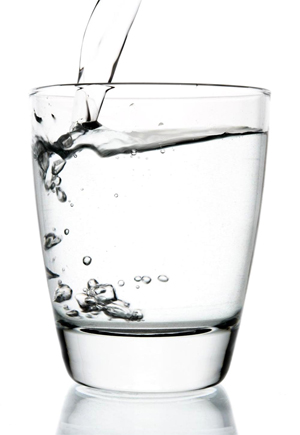Keep Calm and Drink Water
After the winter we all endured, it’s been refreshing to have such warm weather. It feels like we are in the midst of summer after experiencing one of the warmest May’s on record. That said, I thought a quick reminder about staying hydrated would come in handy, as we seem to be headed towards a warm summer.
Typically, an average healthy person’s weight is comprised of about 65% water. Those who are sick and overweight are often as little as 45% water by weight. Chronic dehydration (not drinking enough water) results in skin disease, poor digestive performance, kidney diseases, and even chronic fatigue and headache. Maintaining a consistent water intake can simply help your body function optimally. What is one of the first things many of do in the morning? Go to the bathroom. That is water that your body has already eliminated. Replenish by downing water first thing in the morning (slowly, not chugging). This can help ignite your digestive system, normalize your blood pressure and boost your energy. Get your day started off right. Drinking coffee first thing in the morning only works to promote dehydration. Coffee is a diuretic.
The average adult looses about 10 cups of water a day simply by breathing, sweating, urinating and elimination of waste. A general rule of thumb is to take in half your body weight in ounces of water or if performing strenuous activity, up that to 60-70% of your body weight.
Here are a few things to keep in mind when considering the impact of proper hydration. Consider water to be the magic pill we all yearn for to feel better, minus the pill (you need water to take the pill).
 Fatigue: Water is our most vital energy source. Dehydration causes the enzymatic activity to slow, resulting in fatigue.
Fatigue: Water is our most vital energy source. Dehydration causes the enzymatic activity to slow, resulting in fatigue.
High Blood Pressure: Our blood is approximately 90% water. Dehydration can thicken the blood, causing elevated blood pressure.
High Cholesterol: When the body is dehydrated, it will produce more cholesterol to prevent water loss from cells.
Constipation: Without proper hydration, waste moves slowly through the large intestines, resulting in constipation.
Joint Pain or Stiffness: Cartilage is primary composed of water. When we are dehydrated, cartilage is weakened and joint repair is slow, resulting in pain or discomfort.
Weight Gain: When dehydrated, cells are depleted of their energy source. As a result, we tend to eat more, when we are actually just thirsty.
I hope a few of these resonate with you and motivate you to stay hydrated this summer. As you can see, simply doing this will make an immediate impact on your overall wellbeing. Cheers!
Ready to #feelbetter?
You're just a click away from a wicked good massage!
-

60 Minute Massage Gift Card
$170.00 Add to cart -

90 Minute Massage Gift Card
$255.00 Add to cart -

Mini Aer Small Room Air Purifier
$149.00 Add to cart -
Sale!

Thera-Pearl Sports Pack/Hot Cold
Original price was: $14.99.$12.99Current price is: $12.99. Add to cart -

3 Somadome Sessions Gift Card
$135.00 Add to cart -

20 Minute Somadome Gift Card
$45.00 Add to cart -
Sale!

TheraBand® Stretch Strap
Original price was: $19.99.$14.99Current price is: $14.99. Add to cart -

TheraBand CLX Connective Loop
$14.99 Select options
Muscle Strains
A strain, sometimes referred to as a pulled muscle, is a muscle injury produced by excessive tensile stress that causes fibers to tear within the tissue. A muscle strain does not usually result from excess stretch alone, but from a combination of tension and contraction. Muscle strains can develop when excess tension is placed on…
Read MoreShin Splints or Compartment Syndrome?
One of the most common overuse injuries affecting the lower extremity is the condition known as shin splints. While the term shin splints routinely is used, especially among the athletic population, it does not represent a specific clinical pathology. Instead, it describes chronic shin pain resulting from overuse. It occurs in two regions of the…
Read MoreAn Alternative Approach to Stretching
Clinicians, athletes and rehabilitation specialists advocate stretching as a means for injury prevention and treatment. The primary purpose of any stretching technique is to enhance pliability and flexibility in the soft tissues. It is also routinely incorporated with massage in the treatment of pain and injury conditions. There are many different stretching techniques, which all…
Read MoreGanglion Cysts
The highly refined palpation skills of massage practitioners are such that we often identify tissue abnormalities before the client is aware of them. An indication that we should refer a patient for further evaluation is when we identify something we aren’t sure of but know shouldn’t normally be there. One such example may occur with…
Read MoreWhat Is the “End Feel”?
Some of the most valuable assessment information is derived from relatively simple procedures such as passive range-of-motion tests. While many massage practitioners have been exposed to the fundamental concepts of active and passive range-of-motion testing, most have not learned how to use this information effectively in a clinical environment. In this article, we will focus…
Read MoreHow Accurate Is That Test?
Physical assessment is considered one of the most accurate ways to assess function of the locomotor tissues of the body. While we can often gain valuable information about structural problems through high-tech diagnostic procedures like X-ray or MRI, these procedures tell us very little about the function of the tissues involved in creating and limiting…
Read MoreWhen Is It Tendinitis?
Tendinitis is one of the most common diagnoses for soft tissue pain resulting from repetitive motion. As repetitive motion disorders have dramatically increased, so has the incidence of tendinitis. However, recent investigations into the cellular nature of tendon pathologies have brought forth interesting discoveries that may alter the way tendinitis is treated. In this month’s…
Read More- « Previous
- 1
- …
- 18
- 19
- 20

